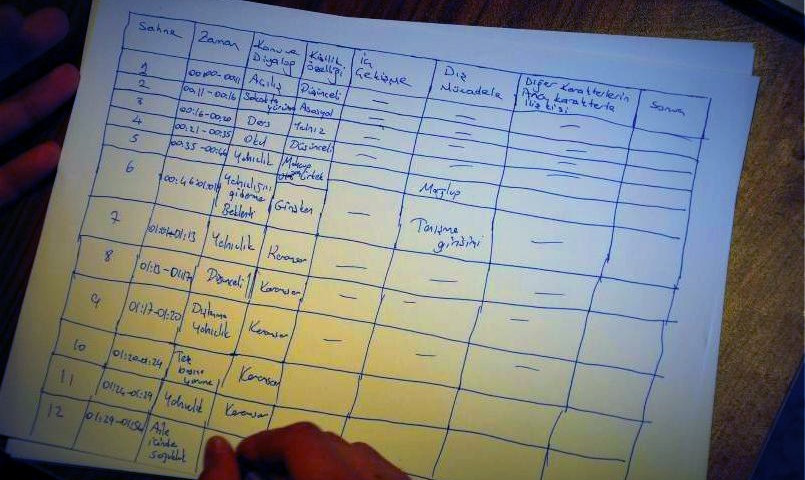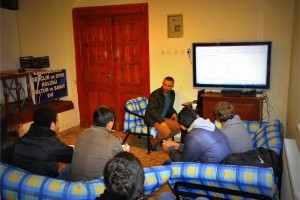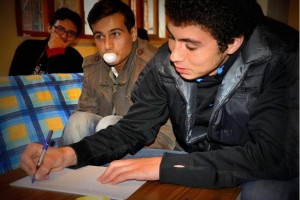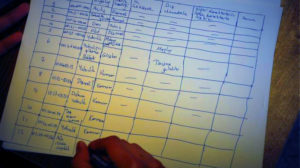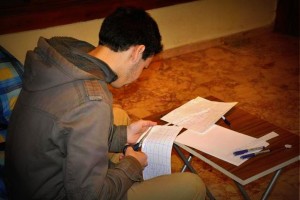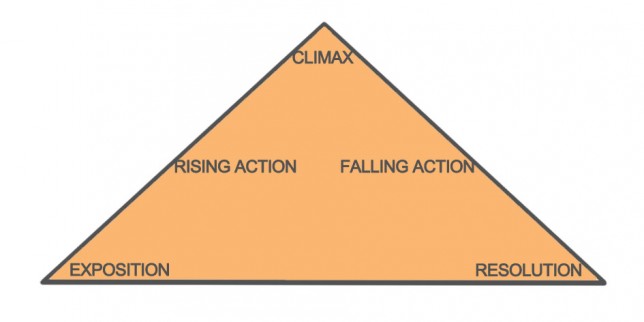Introduction
The content in this chapter is aimed at advanced learners. That’s why we don’t recommend it for young people under 16.
Learning about what makes a good feature film can help you write better scripts and storyboards.
Even if you’re not really interested in writing a script, it’s still useful and fun to analyse what happens in a film. It means you get to know and understand the film better than if you just watched it once. And it makes you a better film-maker.
In this chapter you’ll learn how to analyse the plot and characters of a feature film. There are many ways of doing this, but we focus on the ‚three-act structure‘ theory developed by influential American script-writing expert Syd Field.
| |
Vision in action |
|
Analysing plots and characters can be time-consuming. It’s also not as action-based and physical as filming.But you could still make it a really engaging and fun activity. A great way to do that is to go to see a film at the cinema and think about how the three-act structure applies to it. The main question to answer are:
|
||
Equipment and tools
- To screen and analyse a film in a large group: a screen and projector; a DVD player or computer with internet connection; powerful speakers.
- To screen and analyse a film individually or in small groups: computers, smartphones, tablets or DVD players with screens.
- To make notes: paper and pen, or a digital device.
Main section
Syd Field came up with his theory by analysing many popular films. He found that they basically had the same, three-act structure.
Learning how to analyse a film using Field’s theory will help you see just what it is that makes a good film.
A group of young people analysing a film
Basic terms used in this chapter:
- Act: a self-contained part of the plot, defined by specific characteristics.
- Scene: a series of shots filmed in one location and focusing on a single action or activity over a continuous period of time. For example, the first scene in a film might show a person in a restaurant telling their life story. The second one takes place in the past and shows us what the character described in the first scene, without voice-over narration. In the third scene we see the person sitting in the restaurant again, telling their story.
- Cross-cutting: switching several times between two scenes in different places, to show they are happening at the same time.
- Plot: the overall story told by the scenes in the film; what happens, when, where and why.
- Characterisation and character development:
- Personality traits: a character’s attributes: shy, brave, selfish, generous, and so on. They never remain static: a character may be shy in scene 1 but very outgoing in scene 10.
- Internal conflict: what the character is struggling with inside.
- External conflict: a conflict that occurs between characters. This can be expressed in an obvious way (a physical fight) or subtly (one character looking at another disapprovingly).
- Character relationships: these may be clearly signposted (brothers, lovers, friends) or the audience might have to decode them by carefully observing the characters‘ behaviour towards one another. As with personality traits, relationships aren’t static and can change over the course of the film – for example a loyal employee becoming a disloyal employee.
- Motivation: the motivation for a character’s action is directly linked to their personality traits, internal and external conflicts, and relationship with other characters. Any action will have a motivation – for example returning a stolen apple is motivated by a character’s sense of justice.
- Thematic reference:
A thematic reference is related to the main conflicts in the movie and thus to the character traits and the conflicts of the main character as well. In a movie, for example, where the main character feels guilty for something and wants to get rid of his / her guilt along the plot, guilt may occur as an issue in other parts of the plot as well, for example in the sub-plot and among the supporting actors. - Plot points: According to Field, so-called ‚plot points‘ are found at the end of a film’s first and second acts. A plot point is a significant moment in the film or script that forms the basis for what will happen in the following act. There can be no second act without a plot point in the first, and no third act without a plot point in the second. For example, in the first act of The Matrix, Neo takes a red pill (plot point 1), which allows him to interact with the Matrix in the second act. Plot point 2 is the decision by Neo, Trinity and Tank in the second act to rescue Morpheus. This leads to the third and final act.
The three-act structure
You might already know that classical plays tend to have five acts. According to Syd Field feature films have three, but you’ll soon see the similarities between cinema and Shakespeare!
And here is Syd Field’s three-act structure:
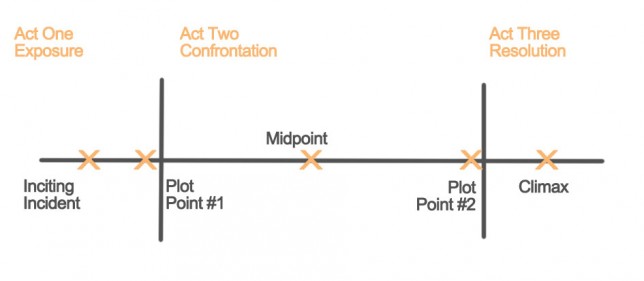 Act 1 (set-up, or exposition) – Act 2 (confrontation) – Act 3 (resolution)
Act 1 (set-up, or exposition) – Act 2 (confrontation) – Act 3 (resolution)
Act 1: set-up, or exposition
The first act usually takes up the first quarter of the film. In a two-hour film, the first act lasts about 30 minutes.
The exposition includes the following elements:
- Introduction of the characters, their relationships to each other, where and when the action is taking place.
- Introduction of the main character, the dramatic premise of the film, and an initial dramatic situation.
- Main character: a person who has some sort of need or objective, and whose actions drive the story.
- Dramatic premise: What is the film about? What’s happening, and what are the main conflicts?
- Dramatic situation: The circumstances around the main character that lead to the conflicts.
- An inciting incident – the event that sets the plot in motion. It happens about halfway through the first act. Everything that led up to the inciting incident isn’t important anymore. Everything that comes after it forms the film’s story. In The Matrix the inciting incident is Morpheus deciding that Neo is the ‚chosen one‘.
- Plot point 1 – a significant event leading to the second act (Neo taking the red pill).
Act 2: confrontation
The second act covers the next two quarters of the film. In a two-hour film, the second act lasts about an hour and includes:
- The obstacles the main character encounters, which prevent him / her from achieving his / her goal.
- The first highlight: just before the midpoint of the film, the main character almost reaches his / her goal but it all falls apart.
- Midpoint: the half-way point in the film. The main character has never been further from reaching his / her goal, and is at his / her lowest point.
- Plot point 2: a significant event that initiates the third act (Neo, Trinity and Tank deciding to rescue Morpheus).
Act 3: resolution and conclusion
The third act is the last quarter of the film. In a two hour movie, the third act would play out over the last 30 minutes.
This act includes the following elements:
- Climax and resolution: the plot reaches maximum tension and opposing forces meet in the form of extreme physical action and / or extreme emotion. The initial dramatic situation and all other conflicts have been resolved.
- Dénouement: the short period after resolution, in which a balanced state is depicted. The picture is often accompanied by relaxing music.
Exercises
- To help you understand the three-act structure better, look online for examples of film analysis referring to Syd Field’s theory. Ideally the films analysed should be ones you’ve already seen.
- Find a short film (max. 20 min) with just one main character (See ‚Related topics/Links to external sources‘ below). Watch and discuss the film: what did you/didn’t you like? What did the film make you think about? How does it relate to you and your life? What touched you?
- Analyse the film using the below table. Download the PDF, then print and glue pages A and B together:
| Scene No. | Time in min:sec | Plot and dialogues | Personality traits of the main character | Internal conflicts of main character | External conflicts of main character | Relationships between main character and other characters | Beginnings and ends of acts/ Plot point 1 / Midpoint / Plot point 2 / Climax / Dénouement |
| 1 | 0:00 – 02:31 | Opening credits | – | – | – | – | |
| 2 | 2:32 – 3:32 | The main character gets into a car. Main character: “Let’s drive to the beach!” Girlfriend: “Hm, I don’t really feel like going to the beach today.” Main character: „Why do you always disagree with me?“ |
Very motivated and happy about going to the beach, quickly irritated | Seems unable to handle the disagreement easily. Maybe doubts the legitimacy of his own wishes? | Disagreement between main character and his girlfriend. There may be long-term, more serious problems between them. | Young couple | |
| … |
- Divide the film into scenes. In the table for analysis, mark any cross-cutting, describe what happens (plot) and include any dialogues.
- For every scene, insert:
- personality traits of the main character
- internal / external conflicts of the main character
- the nature of the main character’s relationships with other characters
- motivations for any actions you describe. Include the motivation in the relevant column where the specific action appears.
- Look for thematic references to the main character’s conflicts. For example, if a film is about alcohol abuse, drinking alcohol might feature in all the film’s scenes.
- Discuss how the film’s plot fits into the three-act structure. Note the following, always referring to the exact time code (start and end time):
- Beginnings and ends of acts
- Plot point 1
- Midpoint
- Plot point 2
- Climax
- Dénouement
Common mistakes
- Confusing the different categories in the table for analysis (personality traits, internal conflicts, etc) and inserting information under the wrong heading. This is not a huge problem, however, as they are all interconnected.
- Rushing through the analysis. It can be hard to define things like plot points, so it takes time to get used to analysing film in this way. Be patient and give yourself enough time to discuss the film in detail with your group.
Related topics and links to external sources
Short movies:
Boy by Lucas Helth Postma (director). Short film (16 min) about intergender issues. In Danish with English subtitles.
[vimeo clip_id=70616895 width=1000 height= ]
Photo mit Ph by Florian Stanger (director). Short movie (25 min). In German, no subtitles available.
maybe we can add a Turkish and a Slovenian movie here]
Methodology
We recommend teaching plot and character analysis using a short film (max. 20min) as a case study.
A classic course structure of four 90min lessons should suit the topic well, but feel free to be flexible. How you organise the course will depend on the length of the film, complexity of the plot, how you conduct the analysis, how many characters you analyse, and how you present the final result.
For example, you might decide to provide the plot and dialogue description for some scenes, to save time. Or you could choose to focus not just on the main character but several others too, for which you’ll need more time.
Elements of the course structure:
- Create interest in the topic of the film and motivate the young people by explaining what they’ll gain from film analysis. Give an overview of the course structure.
- Introduce Syd Field’s theory and explain basic terms relating to the three-act structure. You can use a PowerPoint presentation or a handout.
- Show the three-act structure in action using examples from famous films.
- Together watch the short film the young people will analyse.
- Divide the students into small groups of 2–4.
- Hand out the table for analysis to each group and let the young people glue pages A and B together. Take the first 3 minutes of the film as an example, divide them into scenes, and note down the time code for each.
- Now let each group divide a different section of the film into scenes. When they are done, discuss with the whole group where each scene starts and ends, and note down the exact time code. Also look at any examples of cross-cutting – can the cross-cut shots be combined into whole scenes? Number the scenes in the right order and make sure everyone has the same numbers.
- Each group looks at their assigned scenes and notes down the plot and dialogues.
To speed this up, the young people could use the subtitle files of the film (either in the original language or translated). These will include all the dialogues in the film, with time codes.
The files can be downloaded from the internet, and have extensions *.sub or *.srt. Never download *.exe files, which can be used to deliver viruses, and remember to scan all the files you do download for viruses.
If you’re using a YouTube video, you may find a transcript under ‚More → Transcription‘. Even if this is an automatically generated transcript with some mistakes, you could still us it to create your own transcript of the film.
- Start analysing! Using the first three minutes of the film as an example, insert the following together:
- personality traits of the main character
- internal/external conflicts of the main character
- the nature of the main character’s relationships with other characters
- motivation for all actions you can describe
- if appropriate, any beginnings and ends of acts / plot point 1 / midpoint / plot point 2 / climax and resolution / dénouement
- The young people should now go back to their groups and complete the analysis of their scenes. Don’t let them work on their own for too long. Help them as necessary and, from time to time, discuss the analysis with the whole group.
- When all groups are finished, watch the film again. Discuss what the students found out, scene by scene.
- To present the results, you can cut individual scenes out of the table and glue them onto a banner from left (start of the film) to right (end of the film). You can draw an arrow to serve as a timeline. If you have analysed several characters, paste the strips relating to the main character at the top, and those of other characters below them.
Terminology
Three-Act Structure (consisting of exposition, confrontation, resolution and conclusion), act, scene, cross-cutting, plot, figure characterization and developement, thematic reference, plot point, mid point, main character, dramatic premise, dramatic situation, triggering event, climax, Dénouement

